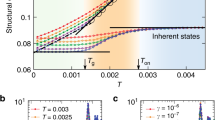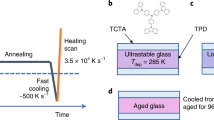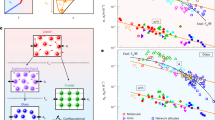Abstract
The glass transition can be viewed simply as the point at which the viscosity of a structurally disordered liquid reaches a universal threshold value1. But this is an operational definition that circumvents fundamental issues, such as whether the glass transition is a purely dynamical phenomenon2. If so, ergodicity gets broken (the system becomes confined to some part of its phase space), but the thermodynamic properties of the liquid remain unchanged across the transition, provided they are determined as thermodynamic equilibrium averages over the whole phase space. The opposite view3,4,5,6 claims that an underlying thermodynamic phase transition is responsible for the pronounced slow-down in the dynamics at the liquid–glass boundary. Such a phase transition would trigger the dynamic standstill, and then be masked by it. Here we perform Monte Carlo simulations of a two-dimensional system of polydisperse hard disks far within its glassy phase. The approach7 allows for non-local moves in a way that preserves micro-reversibility. We find no evidence for a thermodynamic phase transition up to very high densities; the glass is thus indistinguishable from the liquid on purely thermodynamic grounds.
This is a preview of subscription content, access via your institution
Access options
Subscribe to this journal
Receive 51 print issues and online access
$199.00 per year
only $3.90 per issue
Buy this article
- Purchase on Springer Link
- Instant access to full article PDF
Prices may be subject to local taxes which are calculated during checkout




Similar content being viewed by others
References
Angell, C. A. Formation of glasses from liquids and biopolymers. Science 267, 1924–1935 (1995).
Götze, W. & Sjögren, L. Relaxation processes in supercooled liquids. Rep. Prog. Phys. 55, 241– 376 (1992).
Kauzmann, W. The nature of the glassy state and the behavior of liquids at low temperatures. Chem. Rev. 43, 219–256 (1948).
Gibbs, J. H. & DiMarzio, E. A. Nature of the glass transition and the glassy state. J. Chem. Phys. 28, 373–383 (1958).
Adam, G. & Gibbs, J. H. On the temperature dependence of cooperative relaxation properties in glass-forming liquids. J. Chem. Phys. 43, 139–146 (1965).
Menon, N. & Nagel, S. R. Evidence for a divergent susceptibility at the glass transition. Phys. Rev. Lett. 74, 1230–1233 (1995).
Dress, C. & Krauth, W. Cluster algorithm for hard spheres and related systems. J. Phys. A 28, L597 –L601 (1995).
Hansen, J. P. & McDonald, I. R. Theory of Simple Liquids (Academic, London, 1986).
Fuchs, M., Götze, W. & Mayr, M. R. Asymptotic laws for tagged-particle motion in glassy systems. Phys. Rev. E 58, 3384– 3399 (1998).
Doliwa, B. Dynamik harter Kugeln am Glasübergang. Diploma thesis, Univ. Mainz (1999).
Alder, B. J. & Wainwright, T. E. Phase transition in elastic disks. Phys. Rev. 127, 359– 361 (1962).
Buhot, A. & Krauth, W. Phase separation in two-dimensional additive mixtures. Phys. Rev. E 59, 2939 –2941 (1999).
Stillinger, F. H. & Weber, T. A. Packing structures and transitions in liquids and solids. Science 225, 983–989 (1984).
Sastry, S., Debenedetti, P. G. & Stillinger, F. H. Signatures of distinct dynamical regimes in the energy landscape of a glass-forming liquid. Nature 393, 554–557 (1998).
Malherbe, J. G. & Amokrane, S. Asymmetric mixture of hard particles with Yukawa attraction between unlike ones: a cluster algorithm simulation study. Mol. Phys. 97, 677– 683 (1999).
Acknowledgements
We thank C. Alba-Simionesco, J.-L. Barrat and A. Heuer for very useful discussions. L.S. acknowledges support from the Deutsche Forschungsgemeinschaft.
Author information
Authors and Affiliations
Corresponding author
Rights and permissions
About this article
Cite this article
Santen, L., Krauth, W. Absence of thermodynamic phase transition in a model glass former. Nature 405, 550–551 (2000). https://doi.org/10.1038/35014561
Received:
Accepted:
Issue Date:
DOI: https://doi.org/10.1038/35014561
This article is cited by
-
Modern computational studies of the glass transition
Nature Reviews Physics (2023)
-
Zero-temperature glass transition in two dimensions
Nature Communications (2019)
-
Melting and re-entrant melting of polydisperse hard disks
Communications Physics (2019)
-
A theoretical interpretation of free volume at glass transition
Chinese Journal of Polymer Science (2017)
-
Directed percolation identified as equilibrium pre-transition towards non-equilibrium arrested gel states
Nature Communications (2016)
Comments
By submitting a comment you agree to abide by our Terms and Community Guidelines. If you find something abusive or that does not comply with our terms or guidelines please flag it as inappropriate.



